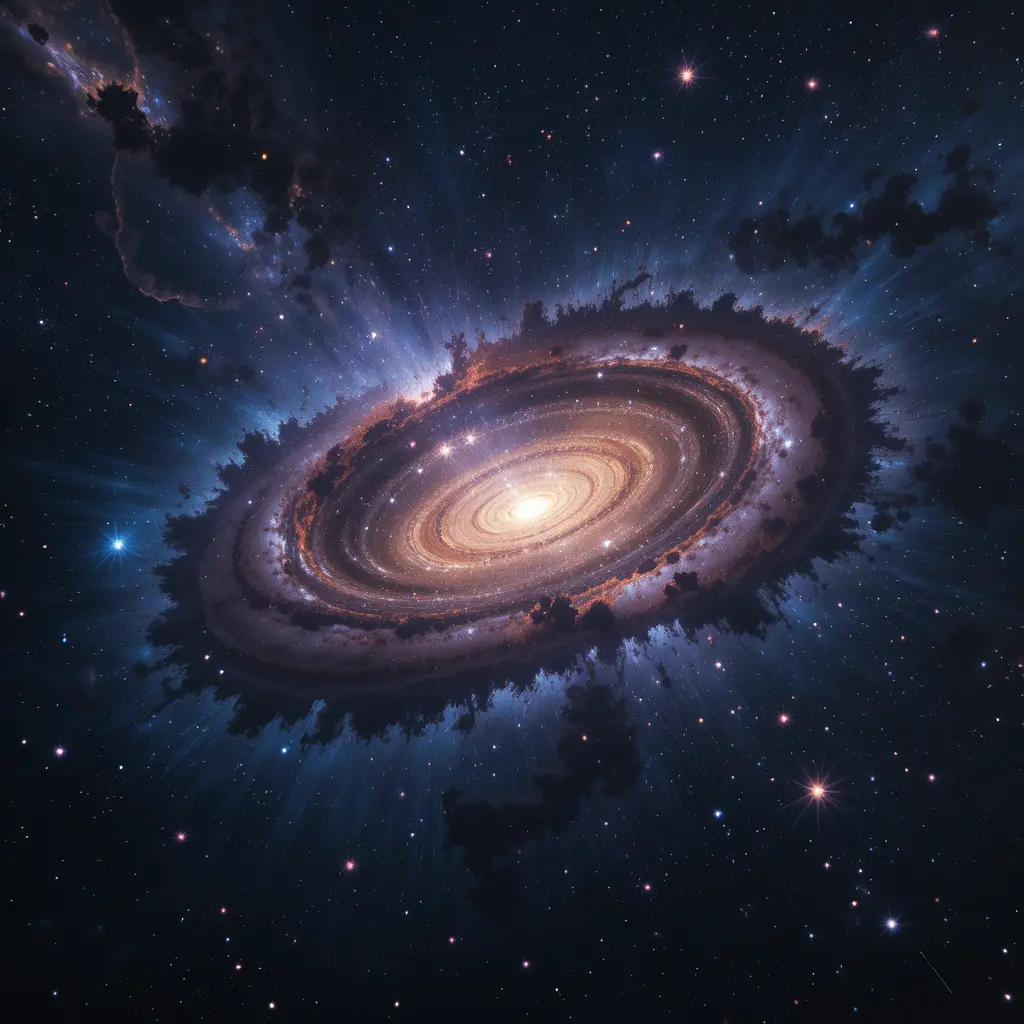What lies beyond the stars, hidden from our view yet shaping the cosmos? Dark matter, an elusive substance, holds the key to many of the universe’s mysteries. Scientists have long been intrigued by its invisible presence and gravitational effects. This article delves into the enigma of dark matter, exploring its role in the universe and the ongoing quest to understand its nature. Join us as we journey through the cosmos, seeking answers to one of the greatest puzzles in astrophysics.
Understanding Dark Matter: The Basics
Dark matter is one of the universe’s most intriguing mysteries. It doesn’t emit light or energy, making it invisible and hard to detect. Yet, it makes up about 27% of the universe. As an astrophysicist, I find this both fascinating and frustrating. Imagine trying to solve a puzzle with most pieces missing. That’s what studying dark matter feels like.
What is Dark Matter?
Dark matter is a form of matter that doesn’t interact with electromagnetic forces. This means it doesn’t absorb, reflect, or emit light, making it invisible. We know it exists because of its gravitational effects on visible matter, like stars and galaxies. For instance, galaxies rotate at speeds that suggest more mass than we can see. This hidden mass is dark matter.
Think of it like wind. You can’t see the wind, but you can see its effects on trees and feel it on your skin. Similarly, we can’t see dark matter, but we can observe its influence on the universe. This analogy helps me explain dark matter to students and friends who are curious about the cosmos.
Why is Dark Matter Important?
Understanding dark matter is crucial for comprehending the universe’s structure and evolution. It acts as a cosmic scaffold, holding galaxies together. Without it, galaxies would fly apart. This makes dark matter a key player in the cosmic dance. Personally, I believe that unraveling the dark matter mystery could lead to groundbreaking discoveries in physics.
In my research, I’ve often felt like a detective piecing together clues. Each new finding brings us closer to understanding what’s hidden in the universe. Exploring the dark matter mystery is like peeling back layers of a cosmic onion, revealing more questions than answers. But that’s what makes science exciting, isn’t it?
The Role of Dark Matter in the Universe
Dark matter is one of the most intriguing components of our universe. It is invisible, yet it holds galaxies together. As an astrophysicist, I find it fascinating how something we cannot see or touch plays such a crucial role in the cosmos. Imagine a world where you can feel the wind but never see it; that’s how dark matter operates in the universe.
The Gravitational Glue
Dark matter acts as a gravitational glue that binds galaxies. Without it, galaxies would fly apart. This mysterious substance makes up about 27% of the universe. I remember my first lecture on dark matter; the professor compared it to a hidden scaffolding that supports a building. This analogy stuck with me, illustrating how essential dark matter is to the universe’s structure.
In my opinion, exploring the dark matter mystery is like trying to solve a cosmic puzzle. We have pieces, but the full picture remains elusive. The universe is vast, and dark matter is a key to understanding what’s hidden in it. Every time I gaze at the night sky, I wonder about the unseen forces at play. It’s a humbling reminder of how much we have yet to learn.
Current Research and Discoveries
In the vast expanse of the cosmos, the enigma of dark matter continues to captivate scientists and enthusiasts alike. As an astrophysicist, I find myself drawn to the question: What is hidden in the universe? This mystery fuels countless hours of research and debate, as we strive to understand the unseen forces shaping our universe.
Breakthroughs in Dark Matter Research
Recent advancements in technology have propelled our understanding of dark matter to new heights. For instance, the Large Hadron Collider (LHC) has been instrumental in simulating conditions similar to those just after the Big Bang. These experiments aim to detect particles that might constitute dark matter. It’s like trying to find a needle in a cosmic haystack, but each discovery brings us closer to unraveling the mystery.
One of the most exciting developments is the use of gravitational lensing. This technique allows us to observe how dark matter bends light from distant galaxies. Imagine looking through a magnifying glass at a distant star. The distortion you see is similar to how dark matter affects light. This method provides indirect evidence of dark matter’s presence and distribution across the universe.
Personal Insights and Anecdotes
During my career, I’ve had the privilege of working with some of the brightest minds in astrophysics. I recall a late-night discussion with a colleague, where we pondered the implications of dark matter on galaxy formation. It was a moment of shared wonder, realizing that our universe is far more complex than we ever imagined. These experiences remind me of the importance of collaboration and curiosity in scientific discovery.
Exploring the Dark Matter Mystery: What’s Hidden in the Universe? remains a question that drives our research. Each step forward is a testament to human ingenuity and our relentless pursuit of knowledge. As we continue to explore, I am hopeful that we will one day unlock the secrets of this elusive substance, revealing the hidden wonders of our universe.
Challenges in Dark Matter Research
Dark matter research is a fascinating yet challenging field. As an astrophysicist, I often find myself pondering the mysteries of the universe. The quest to understand dark matter is like trying to solve a puzzle with missing pieces. We know it’s there, but its elusive nature makes it difficult to study. This challenge is what drives many scientists, including myself, to keep exploring the dark matter mystery: what’s hidden in the universe?
Invisible Yet Influential
One of the biggest challenges in dark matter research is its invisibility. Unlike stars or planets, dark matter does not emit light or energy. This makes it impossible to observe directly. Instead, we rely on its gravitational effects on visible matter. Imagine trying to understand the wind by watching leaves move. You can’t see the wind, but you know it’s there because of its impact. This is similar to how we study dark matter.
Technological Limitations
Another hurdle is the limitation of current technology. Our instruments are not yet advanced enough to detect dark matter particles directly. This is frustrating, but also exciting. It means there’s still so much to discover. I remember a conference where a colleague compared our current tools to trying to catch a fish with a net full of holes. We need better nets, or in this case, more sensitive detectors.
Despite these challenges, the pursuit of understanding dark matter is rewarding. Each small discovery brings us closer to unraveling the universe’s secrets. As we continue exploring the dark matter mystery: what’s hidden in the universe, we remain hopeful. The journey is as important as the destination, and every step forward is a victory for science.
Conclusion
As we delve into the enigma of dark matter, we find ourselves on a journey that is both thrilling and perplexing. The universe holds secrets that challenge our understanding, and dark matter is one of its most intriguing mysteries. This exploration is akin to piecing together a cosmic puzzle, where each discovery brings us closer to a clearer picture of the cosmos.
The Unseen Forces
Dark matter, though invisible, exerts a gravitational pull that shapes galaxies and influences the universe’s structure. Imagine it as the wind that moves the leaves on a tree; you can’t see the wind, but you can see its effects. This analogy helps us grasp the concept of dark matter’s presence. As an astrophysicist, I find this aspect of our universe both humbling and exhilarating. It’s like being a detective in a cosmic mystery, where every clue is vital.
Personal Reflections
In my years of studying the cosmos, I’ve often felt like an explorer charting unknown territories. The quest to understand dark matter is a testament to human curiosity and resilience. I recall a moment during a stargazing event when a child asked, “What’s hidden in the universe?” That simple question encapsulates the essence of our pursuit. Exploring the Dark Matter Mystery: What’s Hidden in the Universe? is not just a scientific endeavor; it’s a journey that connects us all to the vastness of space.





